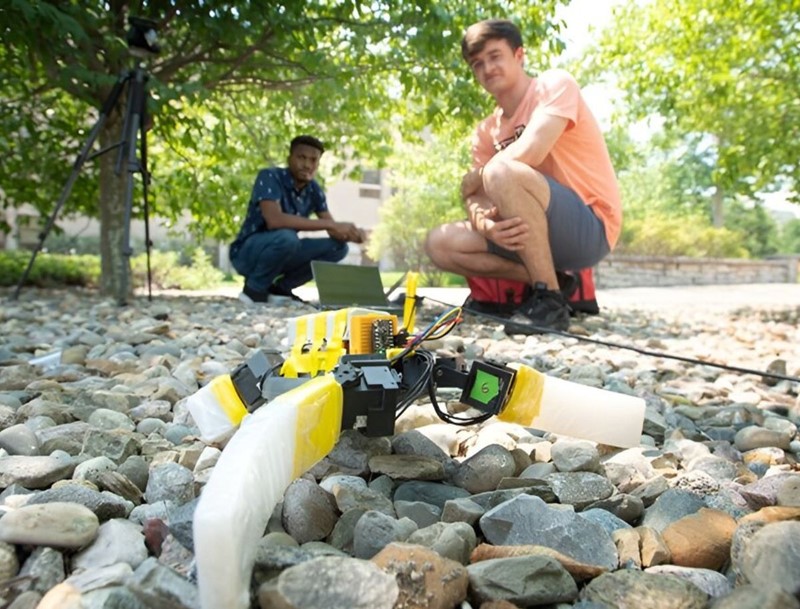Researchers at Notre Dame University are testing a robotic sea turtle that could one day be used to guide turtle hatchlings to the ocean.
The team of researchers designed and built a robotic sea turtle, which they are testing in varied environments on Notre Dame’s campus.
Sea turtles are intriguing animals for scientists due to their locomotive adaptability, which allows them to glide through ocean waters and manoeuvre like armoured vehicles over rocks and sand on land.
Now, the team at Notre Dame believes they have been able to recreate the animal’s unique gait and propulsion. The robot mimics a real sea turtle’s propulsion: its front flippers move it forward, while its smaller hind flippers allow it to change direction.

Nnamdi Chikere and John Simon McElroy with the robot sea turtle model / University of Notre Dame
Image credit: University of Notre Dame
Yasemin Ozkan-Aydin, assistant professor of electrical engineering at the University of Notre Dame, Nnamdi Chikere, electrical engineering doctoral student, and undergraduate John Simon McElroy, a Naughton Fellow from University College Dublin, are putting the robot to the test on the different environments around the university’s campus.
“The sea turtle’s unique body shape, the morphology of their flippers and their varied gait patterns make them very adaptable,” said Ozkan-Aydin.
“Mimicking this adaptability is challenging because it requires an intricate understanding of how morphology, flexibility and gait interact with the environment. Studying how sea turtles adapt their gaits to traverse complex and varied terrains can help us design more versatile robots.”

The turtle robot making its way across varied terrain on campus / University of Notre Dame
Image credit: University of Notre Dame
The robot was designed using data from zoological studies on the morphology, gait patterns and flipper flexibility of multiple sea turtle species.
“To maximise adaptability and versatility, we studied the locomotion patterns of different species and incorporated the most effective aspects from each,” Ozkan-Aydin said.
The key components of their turtle robot are an oval-shaped body, four independently radio-controlled flippers, an electronic onboard control unit, a multi-sensor device and a battery. The body frame and flipper connectors are 3D printed using a rigid polymer. The flippers are made from silicone to provide both flexibility and stiffness.

Nnamdi Chikere and John Simon McElroy testing the robot model / University of Notre Dame
Image credit: University of Notre Dame
Sea turtle babies are particularly vulnerable. Only one in a thousand hatchlings are able to make the journey from the nest into the ocean – avoiding predators and plastic pollution – and manage to survive to adulthood.
The Notre Dame team modelled the robot on the size and structure of sea turtle hatchlings, with the hopes that it can someday be used to protect these animals and ensure the survival of the species.
“Our hope is to use these baby sea turtle robots to safely guide sea turtle hatchlings to the ocean and minimise the risks they face during this critical period,” Ozkan-Aydin said.
Sign up to the E&T News e-mail to get great stories like this delivered to your inbox every day.


